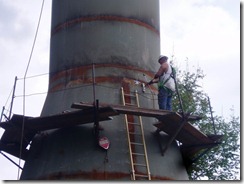Recognizing the Trick Steps in Tank Welding Inspection Procedures
Recognizing the Trick Steps in Tank Welding Inspection Procedures
Blog Article
A Comprehensive Summary of Tank Welding Inspection Requirements and Methodologies for Improved Weld High Quality and Efficiency
The importance of welding inspection standards in the manufacturing of storage tanks can not be overemphasized, as they offer as the backbone for making certain weld honesty and operational reliability. Various inspection strategies, including aesthetic assessments and advanced non-destructive screening methods, are important in determining possible flaws that could compromise efficiency.
Relevance of Welding Evaluation Requirements

Welding assessment criteria incorporate a variety of criteria, including product specs, welding procedures, and qualifications of employees included in the welding process. By implementing these requirements, organizations can methodically determine and fix potential problems, therefore reducing the possibility of pricey repair work or disastrous failings. In addition, strenuous inspection techniques promote a culture of accountability and accuracy, motivating welders to keep high levels of craftsmanship.

Common Welding Inspection Strategies


Ultrasonic Testing (UT) is one more common technique, using high-frequency acoustic waves to detect inner flaws that may not be noticeable externally. This technique is especially efficient for recognizing spaces or inclusions within the weld steel. Magnetic Bit Evaluating (MT) is likewise extensively used, specifically for ferromagnetic products, as it reveals surface and near-surface flaws through the application of electromagnetic fields and ferrous particles.
Additionally, Liquid Penetrant Screening (PT) spots surface-breaking problems by using a penetrant to the weld and after that using a developer to draw out the penetrant. Each of these methods adds to a thorough assessment method, guaranteeing that welds meet the rigid quality standards needed in container anonymous construction.
Regulatory Criteria and Conformity
Regulatory standards and compliance are essential parts in guaranteeing the safety and reliability of welded frameworks in container construction - Tank Welding Inspection. These standards serve to develop minimum requirements for material buildings, welding treatments, and inspection techniques, thereby lowering the threat of architectural failures and boosting total efficiency
Secret organizations, such as the American Culture of Mechanical Designers (ASME) and the American Welding Society (AWS), supply standards that are extensively adopted in the sector. Conformity with these requirements not only guarantees adherence to ideal practices however additionally fulfills lawful and legal responsibilities, safeguarding the passions of stakeholders.
Regulatory bodies frequently mandate adherence to details codes, such as ASME Code Area IX for welding qualifications and API 650 for welded tanks. These codes lay out demands for welding methods, credentials of personnel, and testing approaches to confirm weld honesty.
Normal audits and assessments are essential to maintaining conformity, as they aid determine variances from established standards. Non-compliance can lead to considerable charges, project delays, and security risks. Hence, a robust understanding of regulative criteria and a dedication to compliance are critical in attaining top quality and resilient bonded storage tank structures.
Non-Destructive Testing Approaches
How can the honesty of bonded frameworks be ensured without creating damages? Non-destructive screening (NDT) methods offer a robust service, enabling assessors to click to find out more assess weld quality without jeopardizing the material - Tank Welding Inspection. Among one of the most common NDT techniques are ultrasonic screening (UT), radiographic screening (RT), magnetic fragment testing (MT), and dye penetrant screening (PT)
Radiographic testing entails passing X-rays or gamma rays via the weld, developing images that expose structural issues such as fractures or gaps. This method is important for evaluating the honesty of complicated welds.
Magnetic bit screening is fit for ferromagnetic products, where magnetic areas expose surface and near-surface discontinuities. Dye penetrant screening uses a liquid color to highlight surface-breaking problems, making it a reliable technique for non-porous materials.
Each of these NDT methods has distinct benefits, allowing for detailed analyses customized to particular products and welding procedures. By carrying out these strategies, markets can make sure the integrity and safety of welded structures, eventually improving general efficiency.
Enhancing Weld High Quality Through Assessment
Reliable evaluation plays an essential role in boosting weld high quality, serving as an essential checkpoint in the construction procedure. By determining potential flaws early, evaluations minimize the threat of jeopardized architectural honesty and make certain compliance with industry requirements. Employing a combination of visual examinations, non-destructive screening (NDT) techniques, and mechanical evaluations, assessors can detect issues such as porosity, cracks, and incomplete fusion.
Applying a robust inspection procedure not just improves the overall top quality of welds however additionally cultivates a society of responsibility among look here welders and makers. Normal training and accreditation of evaluation workers ensure that they are geared up with the needed skills to identify and attend to possible problems efficiently. This positive strategy reduces rework and connected costs, inevitably contributing to project effectiveness.
Furthermore, comprehensive documents of examination findings offers useful insights into recurring issues, assisting in continuous improvement in welding practices. By leveraging innovative modern technologies, such as automated ultrasonic testing or digital radiography, weld top quality can be enhanced with a lot more specific assessments. To conclude, a strenuous assessment procedure is crucial in achieving top notch welds, making certain safety, integrity, and durability in container manufacture.
Final Thought
In verdict, the implementation of extensive storage tank welding evaluation requirements and methods is important for making certain weld integrity and efficiency. By using a combination of visual inspections, non-destructive testing methods, and adherence to regulatory criteria, organizations can effectively recognize and alleviate prospective problems.
Report this page